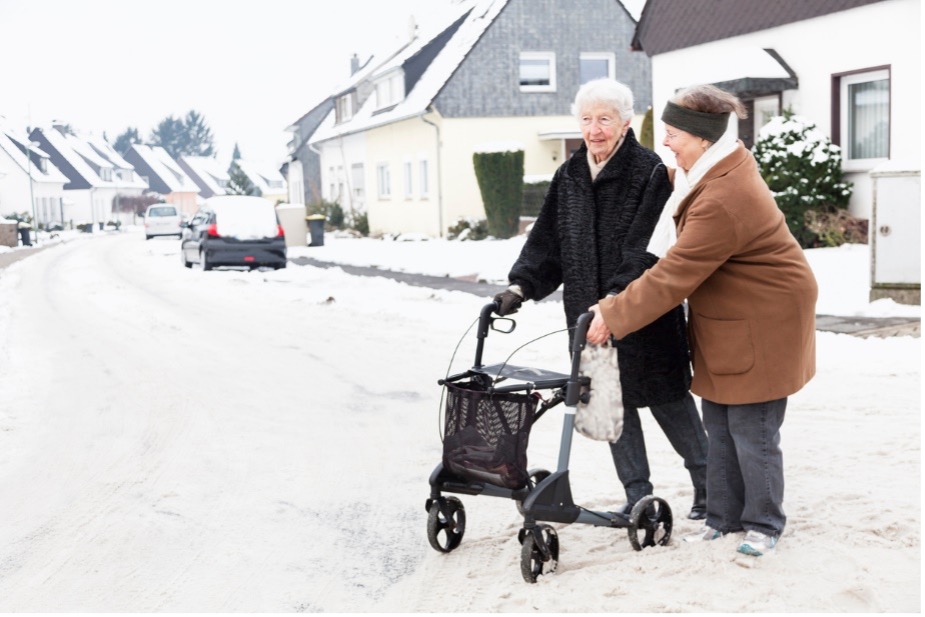Tips for Supporting Vulnerable Community Members This Winter
November 25, 2024

Essential tips, resources, and community care strategies to help vulnerable populations stay safe, warm, and connected during the coldest months.
As temperatures drop and the days get shorter, it’s time to prepare for winter storms and the regularity of colder weather. This is also a good time to think about people in your life and community who may need support preparing for cold temperatures. Whether it’s assisting an elderly neighbor, a loved one with a chronic health condition, or someone experiencing housing instability, offering support is a meaningful way to foster community, give back, and ensure everyone has a safe and warm season.
Who May Require Extra Support This Winter Season?
Winter poses increased health and safety risks, particularly for certain vulnerable populations. If you have loved ones in any of these groups, be sure to check in and offer support as they prepare for the colder months. These groups include:
Individuals experiencing homelessness since cold weather significantly increases the risks of hypothermia, frostbite, and other life-threatening conditions.
Aging adults who face increased challenges as colder temperatures can exacerbate mobility issues, worsen chronic health conditions, and intensify feelings of social isolation.
Low-income families who may struggle with the financial burden of maintaining warm, insulated homes, which place them at greater risk of health complications and financial strain.
Those experiencing chronic illnesses such as cardiovascular and respiratory conditions, which can worsen with the cold, leaving many more susceptible during the winter months.
Individuals with disabilities who may experience difficulties accessing transportation or safely performing winter-related tasks.
Immigrants and refugees may encounter additional hurdles due to language barriers, limited resources, and unfamiliarity with cold-weather preparedness.
Tips for Supporting Vulnerable Individuals Through the Winter Season
While winter preparation is important for everyone, vulnerable populations may struggle with tasks like winterizing their homes or accessing necessary resources. Offering your time and help can go a long way in easing these challenges. Below are some practical ways you can support those in need and ensure a safer, more comfortable winter for everyone.
1. Home Winterization
Completing simple tasks in the home helps to prevent property damage and ensures comfort and warmth throughout the season.
- Minimize heat loss in the home. Caulk and weather-strip doors and windows to prevent heat from escaping. Check window thickness. If the individual’s home has single pane windows, cover windows with plastic on the interior side to help block out the cold.
- Pro-tip: Slide a credit card beneath doors. A gap that a credit card fits through leads to a tremendous amount of heat loss.
- Mitigate fire and carbon monoxide risk. Since items like heaters, candles, and generators greatly increase the risk of fire and carbon monoxide poisoning, checking that the detectors work is key to mitigating those risks.
- Trim tree branches. To prevent property damage from storms, trim any branches that hang low above the home. Offer to trim them yourself or coordinate hiring someone.
- Turn outdoor faucets off. To prevent damage from freezing water, ensure that any outdoor faucets are turned off to keep water from freezing outside. Drain any residual water from garden hoses.
- Simplify temperature regulation. For adults over 65, placing an easy-to-read indoor thermometer can help mitigate health risks from the cold, as aging reduces the body’s ability to sense temperature changes.
2. Vehicle Preparation
Winter driving is well-known for its increased risks and dangers due to icy roads and white-out conditions. Supporting individuals in readying their car for winter travel is key.
- Prepare for a roadside emergency. Assemble an emergency kit that includes winter clothing, a warm blanket, a flashlight, a cell phone car charger, a simple tool kit, safety absorbent to create traction (cat litter works too!), jumper cables, a first aid kit, and a small shovel. Consider assembling several roadside emergency kits and offering them to various individuals in your life who may not have their own ready to go.
- Ensure the car is safe for winter driving. Check coolant levels and tire pressure. Encourage the individual to get their radiator system serviced and if possible, swap out their tires for snow tires to ensure optimized traction.
3. Prepare for a Power Outage
Storms can knock out power for hours or sometimes days, so ensuring that individuals are prepared with key items for prolonged dark and cold is vital.
- Store key items in easily accessible place. Items that provide light like flashlights and battery-powered lanterns as well as warm items such as blankets, sleeping bags, and extra winter coats should be stored in a designated indoor place for easy access. Place a few gallon jugs of water in this place as well.
- Charge external batteries. Cell phones are key communication devices in an emergency so keeping a couple external batteries charged is important.
- Stay informed. Support your friend or loved one in signing up for free emergency alerts from their local government. These will provide key information in a natural disaster such as a large winter storm.
- Reminder: a storm WATCH means Be Prepared and a storm WARNING means Take Action!
4. Snow Removal
Supporting with snow removal is vital for aging adults and individuals with mobility issues, as it reduces the risk of slips and falls, directly improving their health and safety. It also ensures that essential routes, like those to the doctor or grocery store, remain clear and accessible.
- Offer to shovel. Doing so helps prevent falls and keep pathways safe, while also providing you with a great opportunity for physical activity and connection with your neighbors.
- Snow removal services. If snow removal is not an accessible option for you, you can connect your friends and neighbors with no-cost snow removal services, such as Denver Snow Angels who assist Denver residents with snow removal on communal sidewalks or Snowmmatch who connect volunteers with older adult neighbors who require support with snow removal and shoveling for the duration of winter.
5. Manage Medical Needs and Preventative Care
As winter storms and holiday closures can disrupt medical services, it’s essential to ensure individuals have access to the care and medications they need in advance.
- Support individuals in getting vaccinated. With winter comes flu and cold season. Ask individuals if they’ve been vaccinated against the flu and COVID and if not, offer to drive them to an appointment. Use this vaccine provider finder to find free or low-cost vaccine providers.
- Refill necessary prescription medications. To prevent running out of crucial medications during winter storms or other unexpected events, help individuals refill prescriptions in advance.
6. Support Those Experiencing Housing Instability
Individuals experiencing homelessness are particularly vulnerable during the winter months. According to this year’s point-in-time count, approximately 30 percent of unhoused people are unsheltered, meaning they sleep in places considered unfit for human habitation such as cars, abandoned buildings, or on the streets. When temperatures drop below freezing, the risks for unsheltered individuals become life-threatening.
There are ways to help, including sharing information about the below organizations that provide critical support to those experiencing homelessness in Denver, such as:
- Walk-up shelters and free transport: The Department of Housing Stability (HOST) offers a list of shelters offering both walk-up access and transportation options to other shelters. View the free bus route here.
- Winter Gear Drive: Housekeys Action Network Denver collecting collects tents, sleeping bags, handwarmers, warm clothing, and other winter gear to protect unsheltered people. The organizers of this drive have created a wish list of items that people can purchase, which will then be distributed to people experiencing homelessness.
- Multilingual and confidential connection to resources: Mile High United Way’s 211 Help Center connects people with vital resources such as food, shelter, rental assistance, childcare, and more.
Winter preparation is about more than just staying warm—it’s about protecting the health, safety, and well-being of everyone in our community, especially those who are most vulnerable. Whether you’re helping individuals winterize their homes, assisting with medical needs, or supporting those experiencing homelessness, your efforts can have a profound impact. These small acts of kindness and assistance create a safer and more connected community for everyone.
As we approach the holiday season, it’s also a great time to reflect on how we can celebrate in an inclusive and accessible way. To explore ways to make the holidays more accessible for everyone, click here.
Rocky Mountain Human Services wishes you a healthy, happy holiday season.







